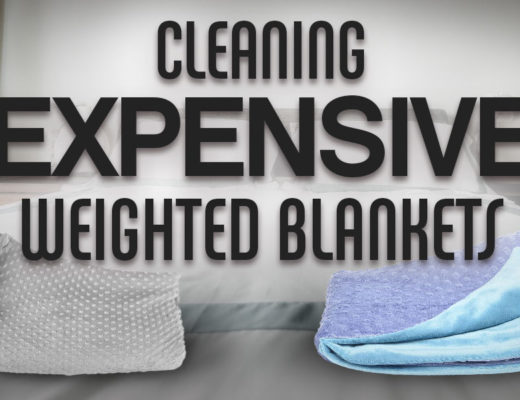Weighted blankets have become popular tools for combating restless and sleepless nights for countless people all around the world. But despite their popularity, some users of weighted blankets are surprised to learn that the blankets they’ve come to love are commonly used in for occupational therapy services. Long before they became a consumer product, weighted blankets weren’t a consumer product and couldn’t be easily found outside of hospitals and doctor offices. In fact, they were originally manufactured as a tool to be used in therapy.
But what is blanket therapy? It’s the use of weighted blankets to alleviate the symptoms of sensory disorders like autism and behavioral disorders like ADD and ADHD. However, everyone can potentially benefit from sleeping beneath a weighted blanket; studies have shown that sleeping with a weighted blanket can help regulate your blood pressure, lower stress, curb depression and anxiety, and a variety sleep disorders. Blanket therapy is a great, non-invasive way to treat a wide range of health issues both physical and mental, but there’s more to it than just buying a weighted blanket. Keep reading to learn the basic ins and outs of blanket therapy.
What Is Occupational Therapy?
As a medical practice, occupational therapy is aimed at helping people with physical and mental disabilities or life-long conditions. Since these conditions do not have known cures. The primary focus of occupational therapy is to teach the patient how they can live independently. By giving them the tools and techniques they can use to cope. Also by minimizing the influence, their condition has on their life.
 Occupational therapists pay equal attention to the physical and social aspects of their patients’ lives. This includes changes that can be made to a patient’s work or living environment to make mobility easier; tools that can be used to increase accessibility and teaching good social skills to improve their everyday interactions with other people. This only touches the surface, but even from the examples given, you can see just how large a field occupational therapy really is.
Occupational therapists pay equal attention to the physical and social aspects of their patients’ lives. This includes changes that can be made to a patient’s work or living environment to make mobility easier; tools that can be used to increase accessibility and teaching good social skills to improve their everyday interactions with other people. This only touches the surface, but even from the examples given, you can see just how large a field occupational therapy really is.
Blanket therapy falls under this umbrella. Sometimes known as weighted therapy (because various weighted objects, like vests, can be used similarly to weighted blankets), blanket therapy can address physical and mental conditions alike, though is most commonly used for the latter by professionals.
How Does Weighted Blanket Therapy Work?
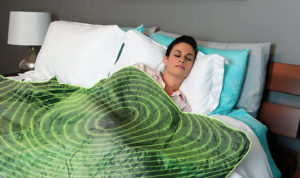 All of the benefits users of weighted blankets experience comes from a single characteristic of the blanket itself: its weight. These blankets are designed to distribute the pressure of their weight evenly across your body, causing a sensation called deep pressure touch simulation. It’s the same feeling you might experience during a long hug. DPTS triggers a process in the body that relaxes your central nervous system while putting your mind and body in a state of deep ease.
All of the benefits users of weighted blankets experience comes from a single characteristic of the blanket itself: its weight. These blankets are designed to distribute the pressure of their weight evenly across your body, causing a sensation called deep pressure touch simulation. It’s the same feeling you might experience during a long hug. DPTS triggers a process in the body that relaxes your central nervous system while putting your mind and body in a state of deep ease.
The even application of weight helps to center those with sensory processing disorders as well as ADHD. Meanwhile, the calming effect it has on your mental addresses mood disorders. Users will sleep beneath the blankets at night, but they are just as effective when wrapped around the body sitting or standing, making them excellent for sudden symptom attacks. The best results are achieved when weighted blanket therapy is practiced every day and not just when it symptoms attack.
Guidance
While some suggest blanket therapy doesn’t necessarily need to be recommended by a medical practitioner to be safely pursued. A doctor or therapist can help you discover what weight is the best fit for you. Most commonly accepted guidelines from manufacturers say the blanket should weigh between 10-15% of your own body weight. There are no established guidelines in the medical community to determine the best weight to achieve certain benefits or treat certain symptoms or disorders. A doctor can help chart your progress through trial and error as you try different blankets. Or they may have own personal recommendations based on past patients that could be a good fit for you as well.
Professional guidance is especially important when you’re looking into blanket therapy for your child. Weighted blankets aren’t inherently dangerous to adults, but the extra pressure they bring, combined with how they can restrain movement, can cause injury or even death to the very young. In some cases, a child is able to get the same effects of weighted blanket therapy by using a regular heavy quilt. You should not allow your infant child to use a weighted blanket without first consulting their doctor.
Blanket Therapy for Sensory Processing Disorders
Those who are living with sensory processing disorders like autism may over-respond or under-respond to something stimulating one or more of their senses. For example, the textures of certain fabrics can cause extreme discomfort in someone with a sensory processing disorder. Understandably, this has an impact on how they choose to live and how they interact with other people. These disorders can be treated but not cured, and will generally last throughout one’s life.
DPTS
 DPTS can be used by occupational therapists to treat sensory processing disorders through sensory integration therapy. This form of therapy sees the patient gets exposed to the triggering sensation in a regular, controlled way. It eventually branches out to include the same sensations exposed in different ways. In time, the reaction over of under-reaction gets closer to normal as the brain becomes more accustomed to the sensation itself, and in the meantime, they are taught different ways to appropriately cope when they find themselves overwhelmed by sensations that are beyond their control.
DPTS can be used by occupational therapists to treat sensory processing disorders through sensory integration therapy. This form of therapy sees the patient gets exposed to the triggering sensation in a regular, controlled way. It eventually branches out to include the same sensations exposed in different ways. In time, the reaction over of under-reaction gets closer to normal as the brain becomes more accustomed to the sensation itself, and in the meantime, they are taught different ways to appropriately cope when they find themselves overwhelmed by sensations that are beyond their control.
The numerous activities and practices sensory integration therapy focuses on are designed to be totally immersive. However, using weighted blankets aren’t one of these activities that’s commonly used. Instead, occupational therapists make use of weighted blankets before beginning a therapy session to help the patient relax. Once at ease, they will be better open to learning and more likely to retain what they learned as well.
However, DPST causes the brain to release the neurotransmitter serotonin, which helps to regulate several functions of the brain, including sensory modulation. Studies have shown that when children with sensory processing disorders turn to a weighted blanket whenever they feel overwhelmed, they return to a calmer, more relaxed state sooner than those who are allowed to simply ride it out. As more studies reach the same conclusions, more therapists are recommending weighted blankets for home use.
Blanket Therapy for Other Disorders
Occupational therapy has been making use of deep pressure therapy for ages to bring patients relief from psychiatric disorders, ADD, and sensory disorders. Traditionally, it is the direct application of pressure to one area of the body. And it’s commonly used in this form of massage to help ease sore muscles. The targeted area begins to relax, and the release of serotonin causes the mind to calm as well.
When DPT is applied to most of the body at once, it has a much wider and deeper effect. The release of serotonin helps you achieve a deeper sleep, minimizes movement in your sleep, lowers anxiety and depression; and improves focus in all areas, including physical coordination. Whereas sensory integration is usually introduced to people when they are children (when the symptoms of sensory processing disorders begin to develop and first show), using blanket therapy for DPT is easily applicable to adults as well.
Occupational therapists use DPT (like sensory integration) in small but continuing short-term doses while encouraging patients to continue to practice in their own time at home. Some of the techniques used in sensory integration therapy, like specific light and sound exposure; can be difficult to duplicate at home, but DPT is easily practiced at home with just a weighted blanket. Whether you choose to wrap yourself up in it during your free time or sleep beneath it at night. The added weight is all that you need to get the benefits at DPT at your leisure.
When Should I Use A Weighted Blanket?
An occupational therapist can advise you on how they think you can best use your weighted blanket at home. But the beauty of it is that you can really use them whenever you want. Children are sometimes advised to reach for their blanket; when the symptoms the blanket is meant to treat a flare-up. But covering up when lounging around the house or sitting at a desk can prolong their effect throughout the day.
However, weighted blankets can be bulky and thus don’t travel easy. Packing them, let alone storing them, makes it difficult to take them out of the house. Adults shouldn’t expect to travel with them easy. Children using smaller blankets may not have as much trouble.
But Which Blanket Is Right For Me?
Developing a regular habit of using your weighted blanket is easy. But before you even get to that step you have to figure out which blanket is right for you. As mentioned earlier, there’s a general consensus about how to calculate how heavy a blanket you should use. But that’s only one part of what is otherwise a more complex decision. There is no “one size fits all” solution; nor can a medical practitioner guarantee that their recommendation will be the best one. When you first begin blanket therapy, you may have to try several blankets before you find your preferred fit.
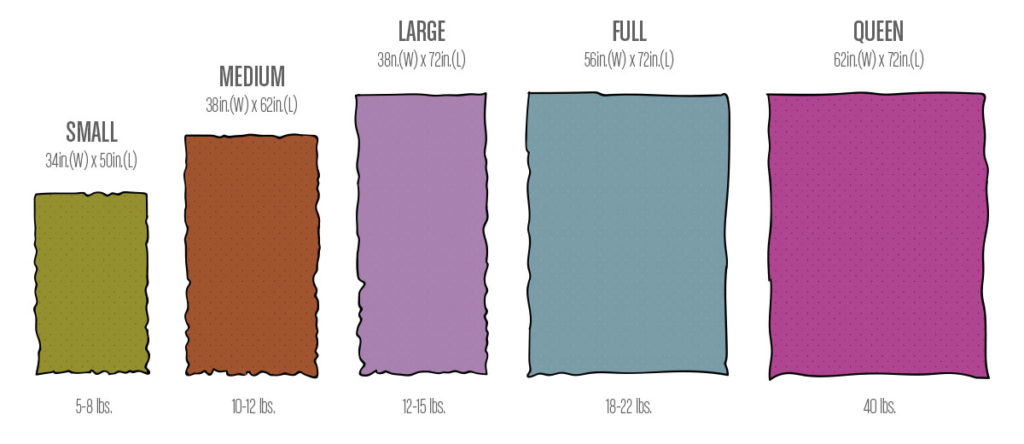 Size
Size
Size is the most obvious consideration next to weight. When you’re shopping around; you need to be aware that sizing a weighted blanket is different than sizing a regular blanket. A weighted blanket only needs to cover you from your feet to shoulders, with a few extra inches all around. It need not be much wider than you are either, and it should never be fitted to the mattress itself.
Beyond that, you’ll want to look at the filler used that gives the blanket its extra weight. Some small objects, usually plastic or glass beads, are sewn into pouches inside the blanket itself. The consideration here is more about comfort than function: you won’t want to to use the blanket if the filler itself feels uncomfortable against your body. There are many different types of fillers, so this is likely where you’ll feel the need to try a few different blankets before you settle on one.
Exterior
Finally, the exterior of the blanket should be looked at closely. While comfort is an issue here as well if you or the intended user have a sensory processing disorder special attention should be paid to the texture of the fabric to see that you don’t purchase a blanket whose exterior could trigger symptoms. Finally, you may want to look into a blanket that includes a removable duvet cover for easier cleaning and maintenance.
Besides these points, it’s a matter of personal preference. You’ll find, for example, some materials are much easier to clean than others, or that some manufacturers design their blankets so that you can add or remove weight as you feel fit. Additional features like these aren’t likely to change how useful your weighted blanket is as a therapy tool.
It’s A Matter of Nature
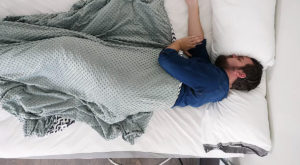 At first, it may be hard to accept that something like a weighted blanket can be just as useful in occupational therapy as powerful as chemically-designed medications, but when you break it down to its bare essentials it’s only natural that your body responds so positively to weighted blankets. They make us feel physically secure, which in turn relaxes us totally. It’s the same effect that can be observed when someone is held or when a baby is swaddled.
At first, it may be hard to accept that something like a weighted blanket can be just as useful in occupational therapy as powerful as chemically-designed medications, but when you break it down to its bare essentials it’s only natural that your body responds so positively to weighted blankets. They make us feel physically secure, which in turn relaxes us totally. It’s the same effect that can be observed when someone is held or when a baby is swaddled.
That being said, blanket therapy isn’t intended to be a replacement for other ongoing medical treatments your medical practitioner has advised you to follow. Rather, it’s a powerful, low-cost way to supplement your care plan. People who are looking towards weighted blankets as an alternative to prescriptions, medical tests, and other procedures will be disappointing. But those who have a proper understanding of what weighted blankets do and what their role in therapy is will be sure to have a great experience.

Chronic Pain? Try Using a Weighted Blanket!
Chronic pain is often an unseen condition, and all to often those who suffer from it choose to remain silent. Some may not realize what they are experiencing is even chronic pain and will instead ignore it in the hopes that it will go away. Those who are fortunate enough to get their problem diagnosed face a new problem in choosing how they wish to treat their pain. Many of the most commonly prescribed pain killers are potentially addictive, while more holistic approaches may be hampered by the pain itself. But can something as simple as a weighted blanket help to treat chronic pain? You may be surprised to learn that weighted blankets can be a powerful tool as part of ongoing treatment. By utilizing deep pressure stimulation, weighted blankets help promote pain relief and deeper, more restful sleep. Though weighted blankets are by no means a cure for chronic pain and related issues, using one as part of an ongoing treatment plan can get you better results. What Is Chronic Pain? The medical community defines chronic pain as any pain that lasts twelve weeks or longer. Such a long window of time should be a clear indicator that something […]

The Best Weighted Blankets
WEIGHTED BLANKETS If you are a restless sleeper, you will have a clear understanding of the struggles to falling asleep and staying asleep the entire night. Most restless sleepers try out different tactics that promise to make them fall asleep and stay asleep for the entire night, without much success. The choice of the blanket is something to consider when determining how easy it will be to fall asleep. People who have tried weighted blankets can attest that the type of blanket you choose will highly influence the likelihood of falling asleep as fast as possible. As their name suggests, weighted blankets are heavy with small pellets filled inside them. The pellets are well distributed, so you do not experience any pressure when you sleep. The best thing about weighted blankets is that they assist in relieving one’s anxiety, which makes it easier to fall asleep because your mind is quiet. These blankets have a calming effect so that even people who have insomnia can experience some level of peace during bedtime. Today, weighted blankets are known to give significant value to those who use them. With a weighted blanket, you would be able to stay warm and comfortable even […]

Do Weighted Blankets Help You Sleep?
“Do Weighted Blankets Help You Sleep? Do They Work For Anxiety And Other Conditions?” Weighted blankets have become something of a craze recently, with countless companies selling their own take on the popular bedding. If you haven’t bought one yourself, odds are good that one of your friends or family members has and can’t stop raving about it. Whenever the praises of weighted blankets are sung amazing health claims are usually included. Devotees swear that the blankets will help restless sleepers stop fidgeting, curb anxiety and stress, crush insomnia, and conquer other a slew of other issues. But what are the benefits of sleeping with a weighted blanket, and are the oft-cited claims real? Nay-Sayers may be surprised to learn that science does, in fact, support many of the health benefits associated with the use of weighted blankets. In fact, it’s not uncommon for therapists and other medical practitioners to recommend them to patients. If you’d like to learn more about weighted blankets and some of their amazing uses, keep reading below! What Is A Weighted Blanket? So you have a loose idea of what a weighted blanket is already. But it’s only when you learn the specifics of how […]
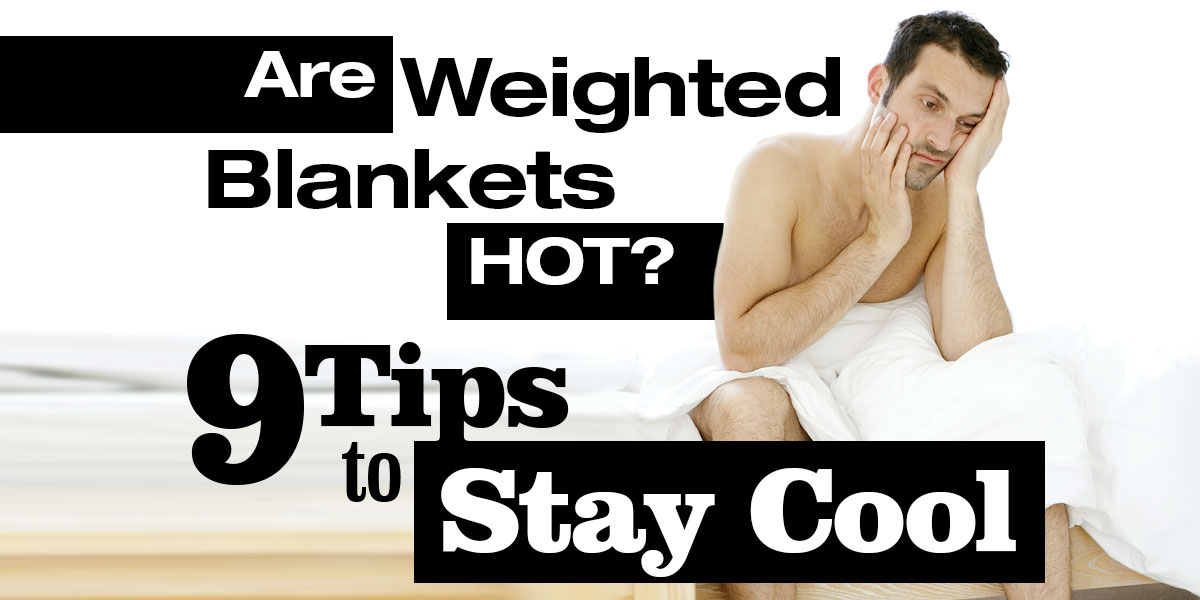
Are Weighted Blankets Hot? 9 Tips To Stay Cool
Weighted blankets are a wonderful tool for helping children and adults alike get a deeper, more meaningful sleep. The additional weight helps the user feel more secure, reduces excess movement, and prompts the body to release more serotonin and melatonin. Ultimately, weighted blankets help your mind and body ease into a state of relaxation. But many people who pass over these incredible sleep aids believe that the added weight will actually make them hotter, defeating their designed purpose. So the question many have is this: do weighted blankets make your hotter when you sleep? The answer is yes, they can, but it depends on what they are made of. Like with clothing, blankets are made with different material, some heavier than others. While much of the heftiness of a weighted blanket doesn’t come from its fabric (it instead comes from the materials used in its filling), heavier material will directly impact heat retention. If you want to experience the joys of a weighted blanket without the risk of a sweaty, sleepless night, consider the following tips. Doing so could make the difference between catching more Zs and tossing and turning all night. Check Out the Filler Material The weight of […]


